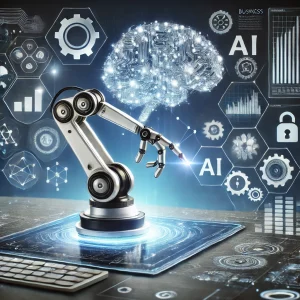
The convergence of Robotic Process Automation (RPA) and Artificial Intelligence (AI) is doing more than automating workflows, it’s transforming the way organisations approach efficiency, innovation, and strategic growth. Together, these technologies create a synergy that’s unlocking new levels of productivity, precision, and potential.
This isn’t just about automating the mundane; it’s about fundamentally reshaping what your organisation can achieve.
RPA and AI: Two Forces, One Vision
To understand the power of this partnership, let’s break it down:
- RPA automates repetitive, rule-based tasks. It’s ideal for processes like data entry, invoice reconciliation, and customer service queries, tasks that demand consistency but don’t require decision-making.
- AI takes things further, introducing intelligence to automation. It enables machines to analyse unstructured data, identify patterns, learn over time, and make informed decisions.
When combined, RPA and AI form Intelligent Process Automation (IPA). This isn’t just automation, it’s automation that learns, adapts, and evolves. It’s a system that doesn’t just follow rules but enhances processes dynamically.
The Impact of Intelligent Automation on Business
Organisations adopting RPA and AI aren’t just improving efficiency; they’re positioning themselves for long-term success. Here’s how:
1. Productivity That Scales
Automation accelerates routine tasks, turning hours of manual effort into seconds. AI complements this by tackling more complex workflows, analysing data, predicting outcomes, and making decisions in real-time.
2. Error-Free Precision
Mistakes in manual processes cost time, money, and reputation. RPA ensures accuracy through consistent execution, while AI improves outcomes by identifying and correcting inefficiencies over time.
3. Built for Growth
As businesses grow, so do their demands. RPA and AI scale effortlessly, handling increased workloads without requiring proportional increases in resources or personnel.
4. Revolutionising Customer Experience
From chatbots that respond instantly to AI systems that anticipate customer needs, this technology creates personalised, seamless experiences that drive loyalty and satisfaction.
Real-World Applications Across Industries
The RPA and AI revolution isn’t limited to a single sector. Here’s how different industries are leveraging its potential:
- Healthcare: Automating patient data management, scheduling, and claims processing, allowing providers to focus more on patient care.
- Finance: Enhancing fraud detection, automating compliance workflows, and speeding up approvals for loans or credit applications.
- Retail: Personalising shopping experiences through AI-driven recommendations while automating inventory and supply chain processes.
- Manufacturing: Using predictive maintenance to minimise downtime, supported by AI that analyses equipment performance in real time.
These aren’t just incremental gains, they’re transformative changes that create competitive advantages.
Overcoming the Challenges
Of course, integrating RPA and AI doesn’t come without its challenges. Success requires thoughtful planning and execution:
- Implementation Complexity: Start small. Begin with low-risk processes and scale as confidence grows.
- Data Quality Issues: AI thrives on high-quality data. Investing in data governance ensures reliable insights and better decision-making.
- Workforce Resistance: Be transparent about how automation supports, not replaces, human roles. Reskilling initiatives can help employees see automation as an opportunity, not a threat.
By addressing these hurdles, businesses can unlock the full potential of intelligent automation.
The Bigger Picture: Automation as a Strategy
RPA and AI are strategic enablers, they empower organisations to:
- Reimagine processes.
- Improve decision-making.
- Enhance agility in a rapidly changing environment.
The key is recognising that this transformation isn’t just technological, it’s cultural. It requires organisations to embrace innovation at every level and to view automation as a pathway to growth.
The Road Ahead
What’s next for RPA and AI? The possibilities are endless, but here are a few areas poised for growth:
- Hyper-Automation: Fully integrating automation across all business functions to create a unified, intelligent enterprise.
- IoT Integration: Using real-time sensor data to automate and optimise workflows.
- Blockchain Synergy: Enhancing security and transparency within automated processes.
These innovations aren’t future concepts, they’re already being used now in forward thinking organisations. The businesses thriving in this new era are those that see the potential, act decisively, and stay ahead of the curve.
